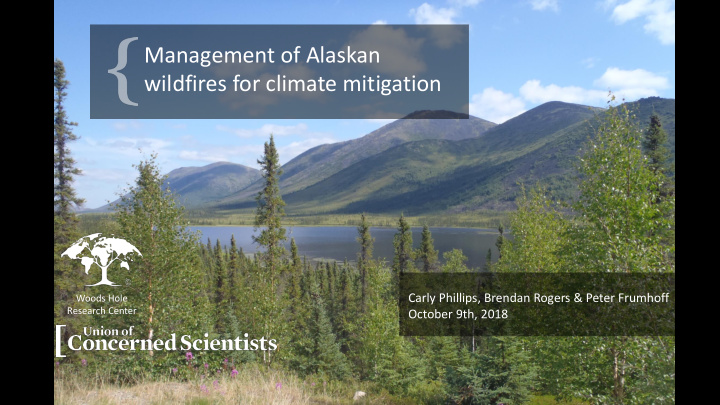



Management of Alaskan wildfires for climate mitigation Carly Phillips, Brendan Rogers & Peter Frumhoff Woods Hole Research Center October 9th, 2018
Rising temperatures RCP 2.6 RCP 8.5 Aggressive reductions Business as usual
Carbon storage Alaska • 18% of US land area • ~1/2 of US land carbon (Zhu and McGuire, 2016) Mishra & Riley, 2012 McGuire et al., 2016 (USGS)
No mention of Alaskan wildfires
Wil ildfire – in increasin ing in in area burned and cost
Future projections Podur and Wotton [2010] Balshi et al. [2009] Terrier et al. [2014] Boulanger et al. [2014] Young et al. [2016] Wang et al. [2015] Krawchuk et al. [2009] North America Wotton et al. [2010] Bergeron et al. [2010] Flannigan et al. [2005] Euskirchen et al. [2009] Amiro et al. [2009] de Groot et al. [2003] Krawchuk and Cumming [2011] Girardin and Mudelsee [2008] Wotton et al. [2003] Flannigan and Van Wagner [1991] Genet et al. [2013] Flannigan et al. [2000] Bachelet et al. [2005] Eurasia Tchebakova et al. [2009] Dixon and Krankina [1993] Kirilenko [2002] 0 100 200 300 400 500 600 700 800 % increase in burned area by 2100
Carbon storage Alaska • 18% of US land area • ~1/2 of US land carbon (Zhu and McGuire, 2016) • ~1/2 of US fire carbon emissions (Veraverbeke et al., 2017; van der Werf et al., 2017)
Cost-Benefit Analysis Give everything a dollar value costs of suppression vs. damages from carbon emissions
A quantitative measure of the long term damage done by a ton of carbon dioxide emissions in a given year $40-50/metric ton CO 2 Social Cost of Carbon (CO 2 ) EPA
September 1, 2015 June 14, 2015 Alaska large fire years (2004, 2005, 2015) • Average 66 Tg C emitted • ~1/3 entire US land C sink • $2.2B – $19.1B using EPA’s social cost of C
Cost-Benefit Analysis
Data for CB Analysis Suppression costs from previous fire seasons ($) Emissions from previous fire seasons (CO 2 -> $) Ecosystem C storage (kg/km 2 -> $/km 2 )
Local & Regional engagement
Federal engagement
We want our project to • Raise the profile of Alaskan wildfire and carbon • Recommend targeted changes to FMZs • Determine where and when suppression is an economically sound climate mitigation strategy
Contact Information Carly Phillips – cphillips@ucsusa.org Brendan Rogers – brogers@whrc.org Peter Frumhoff – pfrumhoff@ucsusa.org Woods Hole Research Center Union of Concerned Scientists – ucsusa.org Woods Hole Research Center – whrc.org
Cost-Benefit Analysis Cost - Pre-suppression Cost -Suppression Net-value change (NVC) Cost+NVC
Fire forcings
Stocks and Martell, 2016
Recommend
More recommend